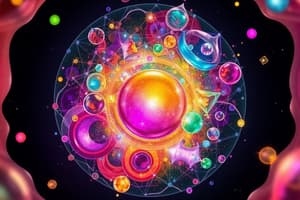Podcast
Questions and Answers
What defines an element?
What defines an element?
- Can be broken down further using current technology
- Always exists in a mixture with other substances
- Consists of atoms with different characteristics
- Composed of one type of atom with identical characteristics (correct)
Which of the following is an example of an element?
Which of the following is an example of an element?
- Oxygen gas (correct)
- Vinegar
- Distilled water
- Table salt solution
What is a characteristic of a solution?
What is a characteristic of a solution?
- Homogeneous mixture with solute and solvent (correct)
- Contains chemically reacting substances
- Forms distinct layers or phases
- Cannot be broken down further
In terms of purity, a solution can contain which type of substances?
In terms of purity, a solution can contain which type of substances?
What distinguishes a mixture from a compound?
What distinguishes a mixture from a compound?
Which example represents a mixture?
Which example represents a mixture?
What distinguishes an element from a compound?
What distinguishes an element from a compound?
Which type of substance is a mixture most similar to?
Which type of substance is a mixture most similar to?
What is the primary difference between a mixture and a compound?
What is the primary difference between a mixture and a compound?
What is the main reason compounds exhibit specific physical properties?
What is the main reason compounds exhibit specific physical properties?
Which term refers to uncontaminated forms of either elemental material or compounds?
Which term refers to uncontaminated forms of either elemental material or compounds?
Which of the following types of matter involves varying amounts of impurities and pollutants?
Which of the following types of matter involves varying amounts of impurities and pollutants?
Flashcards are hidden until you start studying
Study Notes
Understanding Matter's Purity
Matter is all around us—from the solid chair you're sitting on to the liquid water you drink. But did you ever wonder why some things seem more uniform while others appear blended? This exploration delves into the concepts of matter being pure or impure by examining its fundamental components, such as elements, solutions, mixtures, and their various forms.
Elements and Atoms
An element consists of atoms with identical characteristics; they cannot be broken down further using current technology. For example, hydrogen, oxygen, and carbon are individual elements that we find in nature. In terms of purity, when discussing an element, the term implies it exists without any other substance present, meaning it's entirely composed of one type of atom.
Solutions
A solution, on the other hand, occurs when two or more substances combine together, creating a homogeneous mixture where the solute (substance dissolved) and solvent (the substance doing the dissolving) form a single phase. A common everyday solution would be table salt mixed in water. When considered from the perspective of purity, a solution can contain both pure substances—such as distilled water—and impure ones like tap water containing various minerals.
Mixtures
A mixture refers to a combination of two or more substances that do not chemically react with each other, resulting in distinct layers or phases within the mix. Examples of mixtures include sand and water, or cocoa powder and milk. Unlike solutions, a mixture does not achieve complete homogeneity. From a standpoint of purity, these combinations will always have varying degrees of contamination since none of the original particles become transformed into something different.
Types of Pure Substances
Pure substances come in two primary forms: elements and compounds. An element, as mentioned earlier, comprises only one kind of atom, while a compound results from chemical reactions between elements, forming molecules made up of parts of different atomic species. Compounds generally exhibit specific physical properties due to their interactions at molecular levels.
When discussing pure substances concerning purity, we typically refer to them as uncontaminated forms of either elemental material or compounds free from extraneous matter.
In summary, understanding the concepts of matter being pure or impure requires recognizing the differences among elements, solutions, mixtures, and compounds. While purity pertains mainly to elements and certain types of compounds, other states may involve varying amounts of impurities and pollutants. The significance of this distinction lies in our ability to manipulate materials based on desired qualities and end uses.
Studying That Suits You
Use AI to generate personalized quizzes and flashcards to suit your learning preferences.




